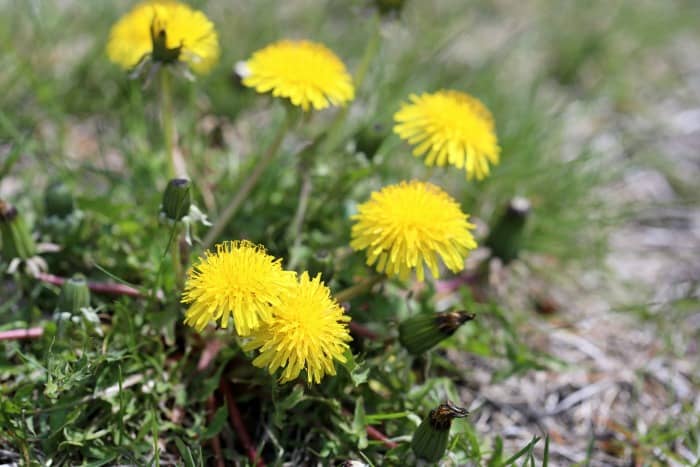Dandelions can completely take over your lawn. Follow this guide to kill dandelions and prevent them from coming back.
What Are Dandelions
Dandelions are an herbaceous perennial plant with yellow flowers. While there are plenty of positive uses for dandelions, they can also be a nuisance lawn weed for those of us who take pride in having a green, manicured lawn.
Dandelions Life Cycle
During the winter, dandelions remain dormant.
In early spring, they are one of the first plants to wake up as soil temps approach 50 degrees. In May and June the flower blooms are most intense. During the day flowers are wide open and bright yellow. During the night flowers close and are not as noticeable.
As flower blooms start to fade, the plant focuses on seed production. Eventually, instead of yellow blooms you’ll notice fluffy white seeds that will be swept away with the wind. These seeds germinate and new plants emerge.
During the hot summer months dandelions are less active and can even go dormant for a short period.
Once soil temps cool off heading into fall they wake back up. It’s normal to see another cycle of flowering followed by more seed production during the fall months. This fall cycle is not as intense as the spring.
Why Are They Tough to Kill
Their overall hardiness and ability to spread an abundance of seed can make dandelions tough to control. Unlike a lot of broad leaf lawn weeds, dandelions don’t die at the end of the growing season. Instead, dandelions are perennial meaning they go dormant during the winter months but will reappear in the spring.
Dandelions are also tough to kill because of their long tap root. A single tap root anchors deep into the soil making manual removal difficult. It’s very hard remove the full root of a mature plant with your bare hands, and if you don’t remove the whole root then the plant will likely survive.
How to Kill Dandelions
1. Dandelion Puller
Using a dandelion puller is a great, organic way to remove dandelions. These puller tools get deep into the ground where the tap root is and they yank out the whole plant including the root. Puller tools are a great option if you have a low to moderate weed problem. Their main benefits are they are safe, eco friendly, and best of all you get instant results.
2. Spot Treat with Lawn Safe Herbicide
Spot treating means spraying each individual plant directly with a liquid herbicide.
* Using a product like Ortho Weed B Gone is a great choice if you have a small to moderate problem, in cool season grasses. This product is also useful in controlling other broad leaf weeds such as crabgrass. It’s also the product I recommend in my simple lawn care program which uses only 3 products. Notice this product comes in a pre mixed ready to use formula with an applicator wand, or you can buy a concentrate which requires mixing with water and spraying with a tank sprayer.
* Another option which is best for warm season grasses, is Image Southern Lawn Weed Killer. The front label says it’s safe to use on St. Augustine and Centipede Grass but it’s also safe to use on other warm season grasses such as Bermuda, and Zoysia. This product is a concentrate and gets mixed with water, in a tank sprayer. Follow the label for mixing ratios.
3. Blanket Spraying
If your lawn has a more serious dandelion problem then it will take forever to spray each individual weed. That is when blanket spraying is a better option. Blanket spraying is when you apply liquid herbicide over your entire lawn, or entire sections of your lawn. This is usually done with a tank sprayer.
Use a liquid, lawn safe weed killer (like the ones listed above), and simply follow the blanket application instructions on the label. Once again, this will target other weeds as well without harming your lawn.
4. Hose End Weed Killer
If you require a blanket application of herbicide but don’t want to invest in a tank sprayer then you can choose to apply an herbicide (listed above) using a hose end sprayer.
Personally, I’m not a huge fan of hose end applications. They can be hard to calibrate and I like the consistency of a tank sprayer better. I also don’t enjoy dragging hoses around my 23,000 s/f lawn. But plenty of people use hose end sprayers and for smaller lawns they make a lot of sense.
Granular Post Emergent Herbicides on Dandelions
I’m not a big fan of granular post emergent herbicides for controlling dandelions. Once a dandelion plant is already establish you’re going to have much better results using a weed puller, spot treating, or blanket spraying using a liquid herbicide.
Granular post emergent herbicide products like Weed & Feed require very specific conditions to get the herbicide to stick to the plant. Even then, these products have mixed results for your typical homeowner.
How to Prevent Dandelions
Preventing dandelions really comes down to 3 things:
1. Pre Emergent Herbicides
Unlike granular post emergent herbicides, granular pre-emergent herbicides are noticeably effective. My go to granular pre-emergent herbicides are Prodiamine and Dithiopyr. These products need to be applied at the right time to be effective. Check out this post where I talk about pre-emergents and timing: Lawn Care Program
Just remember, dandelions are perennials. That means pre-emergents will prevent new dandelion seeds from emerging, but it will not prevent the dandelions that have overwintered in your lawn from coming back.
2. Killing Existing Plants
Since mature dandelions produce seeds that eventually become more dandelions, killing existing plants is key in controlling the problem. Manual pulling, and spraying weeds with a liquid herbicide are great ways to kill existing plants.
3. Mowing
Mowing frequently and bagging your clippings is going to help control the spread of dandelions. Mowing cuts off the flower portion of the plant, making it impossible to produce seeds. Collecting the clippings prevent the seeds from being mulched back into your lawn.
Check Out These Posts Next
How to Kill Weeds Without Killing Grass
White Grubs: Prevention and Treatment
Follow Me
Join my free email list!
Plus, follow me on Facebook, Instagram, and Pinterest.


Leave a Reply